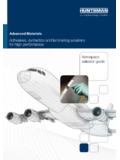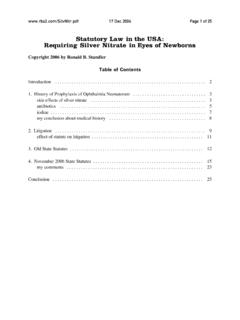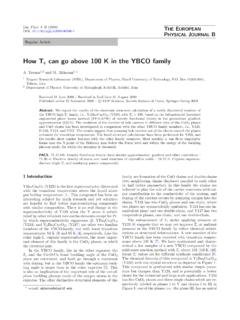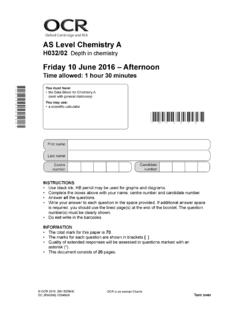Transcription of Ch. 2 Answer Key - lawndalehs.org
1 Section Review ; two main types of chemi-cal bonding are ionic and covalent bonding . Ionicbonds are formed when a transfer of electrons takesplace from one atom to another, and covalent bondsare formed when electrons are shared between atom becomes an ion when it gains or loses oneor more and protons are bothcomponents of atoms; however, they have differentcharges and locations within the atom. Electrons arenegatively charged and found outside the nucleus,while protons are positively charged and found insidethe nucleus. Electrons are also much smaller than atoms are joined together by covalentbonds, the structure that results is a of radioactive isotopes that is useful for dat-ing is the constant rate of Review in awater molecule is caused by an uneven distributionof electrons between the oxygen and concentration of H ions determineswhether a solution is acidic or is the effect of water rising in a narrow tubeagainst the force of gravity.
2 Cohesion holds the mole-cules of water together as they Two types ofmixtures are solutions and suspensions. In a solution,all the components are evenly distributed throughoutthe solution. In a suspension, small particles mixedwith water are not dissolved but are kept suspendedby the movement of water base is a compound that can form a basic solution solutions have a lower pHthan water. This is due to their greater concentrationof H ions than pure water. Pure water has a pH of 7and contains equal concentrations of H and OH acids and bases are dangerous to cells. Buffers are dissolved compounds that helpprevent sharp, sudden swings of Review acid (RNA), deoxyribonucleic acid (DNA) atoms have 4outer electrons and therefore can form 4 strong, stable,covalent bonds. Carbon can also bond with other car-bon atoms, which gives it the ability to form chains andrings.
3 These carbon carbon bonds can be single, dou-ble, or triple plastics and polysaccha-rides are organic polymers, or chains of carbon-containing molecules. Polysaccharides are naturallyoccurring molecules found in the body, while plasticsare synthetic molecules made in factories or Review catalyst lowers the activationenergy. An enzyme is an example of a catalyst. Itworks by attaching to the chemicalreaction involves reactants changing to products. Acatalyst is often needed to begin the chemical A has the greatest activation 1 shows a reaction that absorbs B is the reaction pathway withoutenzyme, and Pathway C is the reaction pathwaywith enzyme. The enzyme lowers the imaginary enzyme would workbest when the body temperature is , students answers should mention a func-tion involving recovery from fever, or reduction ofbody temperature after Vocabulary , der Waals sodiumatom is a neutral particle that contains equal num-bers of protons and electrons.
4 A sodium ion is asodium atom that has a positive charge because ithas lost an is an attractionbetween molecules of the same substance, andadhesion is an attraction between different is the solvent because it is thesubstance that the salt is dissolved in, and salt isthe solute because it is the substance that is are compounds that have higherconcentrations of H ions than water and have pHvalues below 7. Bases are compounds that havelower concentrations of H ions than water andhave pH values higher than catalyst is asubstance that speeds up the rate of a chemicalreaction by lowering the activation energy. The sub-strate is the reactant in an enzyme-catalyzed acid22. answers should include blood. Many sub-stances in the environment are colloids, such assmoke, fog, and in a colloid areusually much smaller than particles in a particles tend to settle out after a periodof time, and colloid particles will continue to mixwith the liquid or gas that they are suspended both can be made up of solids, liquids, or gasesin some Organizer: Concept , nitrogen, acidsChapter 2 The Chemistry of LifeANSWER KEYT eaching Resources / Chapter 231 Pearson Education, Inc.
5 All rights 10/29/01 11:02 PM Page store energy; to formbiological acids12. ; RNAD esign an ExperimentAnalyze and catalyzes a reaction that releases oxygengas. Bubbles of oxygen form around the filter-paper disk, lifting it to the surface of the liquid. The more active the enzyme, the more quickly bubbles suffi-cient to lift the disk are possible stu-dent Answer would be that temperature directlyaffected the catalase activity. A student s predictionthat an increase in temperature would lead to anincrease in catalase activity would be correct. Correctstudent data should also show the catalase activitydropping off at temperatures beyond 45 answers should show that the graph didindicate the catalase being most active around 37 Resources / Chapter 2 Pearson Education, Inc. All rights 10/29/01 11:02 PM Page 32









